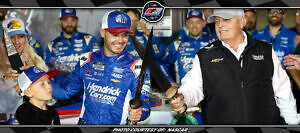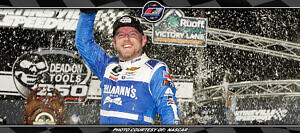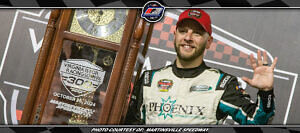
Column By: REID SPENCER / NASCAR – SPEEDWAY, IN – Forty years before the first modern-era stock cars took to the track in anticipation of a race at Indianapolis Motor Speedway, NASCAR founder “Big Bill” France was ushered ignominiously out of the Indianapolis 500 garage.
That was in 1954, and France, along with fellow NASCAR Hall of Famer Junior Johnson, was paying a visit to the greatest open-wheel spectacle in motorsports.
The visit didn’t last long. According to a 1994 Norfolk Virginian-Pilot story by veteran racing writer Bob Zeller, chief steward Harry McQuinn got an urgent message during Indy Speedweeks, noting that France was in the garage.
“Kick him out,” McQuinn replied.
According to Zeller, the 1954 Floyd Clymer Indy Yearbook notes that France “was given the old heave-ho.”
France’s exit wasn’t born of personal animus. He had no beef with IMS owner Tony Hulman. Problem was, France was considered a competitor by the powers that be in the American Automobile Association and the United States Auto Club, which succeeded the AAA.
France already had dreamed of building a speedway in Florida to rival Indianapolis. His experience in the Indy garage only hardened his resolve. Five years later, Daytona International Speedway hosted its first Daytona 500.
Reconciliation with Indianapolis Motor Speedway was much slower in coming. Not until Tony George succeeded Joe Cloutier as president and CEO of IMS in 1989 did earnest talks between NASCAR and the speedway take place.
Big Bill France didn’t live to see modern NASCAR cars cross the yard of bricks. He passed away on June 7, 1992, 15 days before a handful of Cup drivers tested at the speedway.
According to Speed Sport, the first day of the test, June 22, was coldest on record for that date, prompting Kyle Petty to quip, “Everybody always said it’d be a cold day in hell when we raced at Indianapolis.”
A crowd estimated at 25,000 to 30,000 viewed the test. Another 35,000 fans were turned away. In August of 1993, NASCAR held a full-field test featuring 35 teams, with Bill Elliott turning the fastest lap of the two-day test at 167.467 mph.
NASCAR fans looked forward to the 1994 inaugural Brickyard 400 with enormous anticipation. Indy purists, on the other hand, wanted to restrict the track to the Indianapolis 500 and took great glee in derisively calling the stock cars “NASCAR taxicabs.”
Controversy aside, Jeff Gordon won the first Brickyard 400 on Aug. 6, 1994 in front of 350,000 fans, as listed in Racing Reference. Legend has it that the debut race could have sold out twice over.
Gordon went on to win the event a record five times before the last Brickyard 400 on the 2.5-mile “big track” took place in 2019. All told, 18 drivers have participated in both the Indianapolis 500 and the Brickyard 400.
No driver has won both events, though Juan Pablo Montoya came close—twice. Winner of the Indianapolis 500 in 2000 and 2015, Montoya finished second to Tony Stewart in the 2007 Brickyard 400. In 2009, he led 116 of 160 laps but finished 11th after incurring a pit road speeding penalty in a car that had thoroughly dominated the race.
“I swear on my children and my wife that I was not speeding,” lamented Montoya, who was flagged with 35 laps left. “There is no way!”
Timing and scoring said otherwise.
NASCAR did not race at Indianapolis during the 2020 pandemic year, and in 2021 the schedule shifted from the oval to the Indianapolis Motor Speedway Road Course. This weekend, NASCAR Cup and IndyCar will share the same stage—racing on the same track on consecutive days.
That’s a far cry from the days when Big Bill France wasn’t welcome in the IndyCar garage.
Rumors that the Brickyard 400 will return in 2024, the 30th anniversary of the inaugural race, appear to have substance, given that Goodyear has scheduled a tire test on the Indy oval on Aug. 14-15—immediately after the Aug. 13 Cup Series race on the road course.







